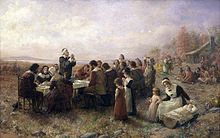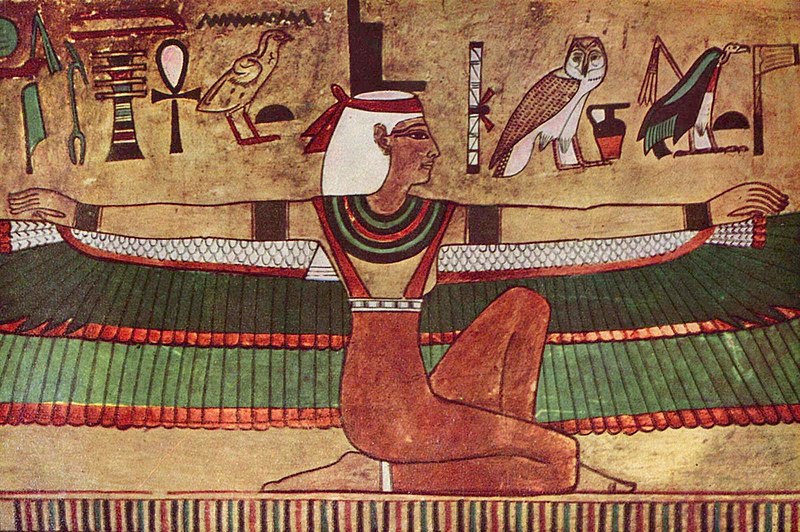November  (listen) (help·info) is the 11th month of the year in the Julian and Gregorian Calendars and one of four months with the length of 30 days. November retained its name (from the Latin novem meaning "nine") when January and February were added to the Roman calendar.
(listen) (help·info) is the 11th month of the year in the Julian and Gregorian Calendars and one of four months with the length of 30 days. November retained its name (from the Latin novem meaning "nine") when January and February were added to the Roman calendar.
November is a month of spring in the Southern Hemisphere and autumn in the Northern Hemisphere. Therefore November in the Southern Hemisphere is the seasonal equivalent of May in the Northern Hemisphere and vice versa.
November starts on the same day of the week as February in common years, and March every year. November ends on the same day of the week as August every year.
In the pagan wheel of the year, November begins at or near Samhain in the Northern Hemisphere and Beltainein the Southern Hemisphere.
November symbols
- November's birthstones are the topaz (particularly, yellow) and the citrine.
- Its birth flower is the chrysanthemum.[4]
- The Zodiac signs for those born in this month are Scorpio and Sagittarius

Events in November
- All Saints' Day (formerly All Hallows Day), a Christian holy day, is celebrated on November 1. The day before, Halloween, is therefore "All Hallows Eve". In Sweden the All Saints' official holiday takes place on the first Saturday of November. The 2011 Swedish All saints day will take place on November 5.
- 1 November – Day of the leaders of the Bulgarian national revival
- In Ireland, November 1 is regarded as the first day of Winter.
- November 1 is called November Day (Lá Samhna) in Celtic tradition and is thus named in theIrish Calendar, where the month is called Mí na Samhna.
- In the Roman Catholic calendar, November 2 is All Souls Day. It is known in Mexico as el Día de los Muertos (Day of the Dead), and the whole month of November is especially dedicated to praying for the dead
- Britain and New Zealand celebrate Guy Fawkes Night, the anniversary of the failed Gunpowder Plot, on November 5.
- In Indonesia, November 10 is known as National Heroes Day.
- November 10 is the birthday of the United States Marine Corps.
- Independence Day in Poland on November 11.
- Remembrance Day is celebrated on November 11 in the Commonwealth of Nations and various European countries (including France and Belgium) to commemorate World War I and otherwars. It is known as Veterans' Day in the United States.
- In India, Children's Day is celebrated on November 14, the birthdate of first Indian Prime Minister Pandit Jawaharlal Nehru.
- The Leonids meteor shower reaches its peak around November 17.
- Latvian Independence day November 18.
- Discovery to the Eastern World of Puerto Rico by Christopher Columbus on November 19, 1493.
- International Men's Day is commemorated on the 19 November.
- Día de la Revolución, or Revolution Day, is celebrated in Mexico on November 20.
- Transgender Day of Remembrance has occurred on November 20 each year in the United States since 1999.
- National Adoption Day – November 21
- Independence Day in Lebanon on November 22.
- Rudolf Maister day in Slovenia on November 23
- On 24 November each year, Lachit Divas is celebrated statewide in Assam, India, to commemorate the heroism of the great general Lachit Borphukan and the victory of the Assamese army over the Mughal army at thebattle of Saraighat in 1671.
- Suriname celebrates its Independence Day on November 25.
- Albanian independence day is on November 28.
- Scotland celebrates St Andrews Day, its official national day, on 30 November. Since 2006 it has been an official bank holiday.
- Argentina celebrates the Day of National Sovereignty on 20 November, to conmemorate the Vuelta de Obligado battle. It has been declared an official national holiday in 2010
- The United States and Puerto Rico observe Thanksgiving on the fourth Thursday in November.
- For Western Christians, Advent usually begins on a Sunday during the last week of November.
[edit]Month-long observances
- Native American Heritage Month
- Pancreatic Cancer Awareness Month
- COPD Awareness month [1]
- National Novel Writing Month
- Alzheimer's Disease Awareness Month
- American Diabetes Month
- Lung Cancer Awareness Month
- National Homeless Youth Awareness Month
- Crohn's & Ulcerative Colitis Awareness Month
- National Pomegranate Month in the United States [2]
- Holy Souls in Purgatory (Roman Catholic Church)
- International Drum Month
- National Stomach Cancer Awareness Month (United States)
- Epilepsy Awareness Month
[edit]Movable events
First Tuesday
- In Australia, the Melbourne Cup horse race is held annually on the first Tuesday in November.
Tuesday After the First Monday
- In the United States, elections are held on the Tuesday after the first Monday of November (between November 2 and November 8). In even-numbered years, members of the House of Representatives are elected to two-year terms, and about one third of the U.S. Senateare elected to six-year terms. The President of the United States is elected in doubly even-numbered years . Most U.S. states, counties, and municipalities have some part of their election cycle coincident with this date.
Third Wednesday
- GIS Day is held the third Wednesday of November during Geography Awareness Week.
Third Thursday
- The Great American Smokeout sponsored by the American Cancer Society occurs on the third Thursday of November, one week before Thanksgiving. Smokers are encouraged to quit smoking for these 24 hours, in hopes that they will quit forever.
- Beaujolais nouveau is released. [3]
Fourth Thursday in the US
- Americans celebrate Thanksgiving on the fourth Thursday of November.
The day after Thanksgiving in the US
- A famous day for shopping known as "Black Friday".
- Buy Nothing Day
Monday immediately following Thanksgiving Day in the US
Nicaragua Weather and Climate
Best time to visit:
The climate in Nicaragua differs according to region, so the best time to go varies. The climate is tropical for most of the country. The dry season is from December to May, and the rainy season is from June to November. On the Pacific side the rainy season runs from May to November. Summer and the dry season, is November to April, with the busiest time being from December to March. The climate on the Atlantic side can be very temperamental and can often be rainy.
Required clothing:
Lightweight cottons and linens are required throughout the year. Waterproofs are advisable during the rainy season. Warmer clothes are advised for the northern mountains.
Geography:
Nicaragua borders Honduras to the north and Costa Rica to the south. To the east lies the Caribbean, and to the west the Pacific. In the north are the Isabella Mountains, while the country's main feature in the southwest is Lake Nicaragua, 148km (92 miles) long and about 55km (34 miles) at its widest. The island of Ometepe is the largest of the 310 islands on the lake. These islands have a reputation for great beauty and are one of the country's main tourist attractions. Lake Managua is situated to the northwest. Volcanoes, including the famous Momotombo, protrude from the surrounding lowlands northwest of the lakes. The country's main rivers are the San Juan, the lower reaches of which form the border with Costa Rica, and the Rio Grande. The Corn Islands (Islas del Maiz) in the Caribbean are two small beautiful islands fringed with white coral and palms. They are very popular as holiday resorts with both Nicaraguans and tourists.
Climate & when to go
Nicaragua has a range of microclimates, and it's always worth checking the weather to see where you want to go first. On the Pacific side, invierno (winter), or rainy season, runs May to November, at its rainiest in September and October when sea turtles nest 3000-strong to a beach. Verano (summer), or dry season, is November to April, the best time for hiking, camping and partying, as it coincides with high tourist season (December to March), most pronounced along the Costa Rican border. Asverano desiccates to a close, the Pacific forests lose their leaves and lake levels drop revealing sandy lake beaches that you'll put to good use as temperatures soar from the normal high 20s into the mid-30s or worse.
And then there are the mountains, from the islands of cool cloud forests atop each volcano to the monolithic granite peaks of the central highlands, where the seasons become blurred in the chilly misty mornings, with temperatures between 12°C and 24°C. On the Atlantic side rainy and dry seasons are almost entirely academic, so check the weather; along the Río San Juan, one of the wettest places on earth, always pack a raincoat.
The climate in Nicaragua differs according to region, so the best time to go varies. The climate is tropical for most of the country. The dry season is from December to May, and the rainy season is from June to November. On the Pacific side the rainy season runs from May to November. Summer and the dry season, is November to April, with the busiest time being from December to March. The climate on the Atlantic side can be very temperamental and can often be rainy.
Required Clothing
Lightweight cottons and linens are required throughout the year. Waterproofs are advisable during the rainy season. Warmer clothes are advised for the northern mountains.
Required Clothing
Lightweight cottons and linens are required throughout the year. Waterproofs are advisable during the rainy season. Warmer clothes are advised for the northern mountains.







